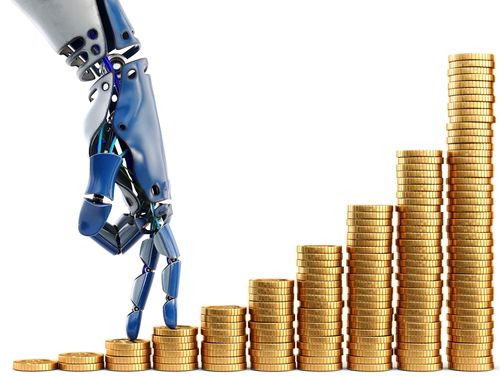We’re constantly striving to stay at the top of our industry, which is tough being in the ever-changing and fast-maturing digital world. And the non-sexy sectors we work with are not lagging behind. In fact, the manufacturing and technology sectors are seeing a period of rapid change.
The onset of AI, automation and robotics is a natural progression from Just in Time and Lean manufacturing, enabled by huge changes in the technologies that support them.
Industry 4.0 should have come as no surprise to anyone.
It's rare, though, to see a seismic change in these traditional industries being followed so swiftly by the next big change. And these aren’t just ‘trends’, these are big changes which will have a massive impact on the entire supply chain right through to the end customer.
Where Industry 4.0 left us
Industry 4.0 hasn’t even got going yet and we’re already hurtling towards 5.0. It’s less of a single, crazy, exponential curve and more like a series of tsunamis heading at manufacturers, the first one hasn’t even receded before the next hits the shore like… well, like a tidal wave.
All about automation
Just by way of recap, let’s skip Industry 1-3 and go straight to 4.0, which is (not ‘was’, it’s still ongoing) all about automation. AI, streamlined manufacturing, cognitive processes, IoT, robotics, take your pick of acronym or buzzword. Replacing or augmenting static, laborious or in many cases human activity with faster, perfectly replicable actions, smart connected machinery.
The net result is a better working factory or assembly line, or processing plant.
Although this is a predictable phenomenon derived by the advance of technology, it wouldn’t be nearly as much fun (and yes I mean ‘wouldn’t) if we didn’t slap a convenient term on it. So we called it Digital Transformation.
And that’s where the danger starts; talk to people about Digital Transformation and you’ll get a bunch of different interpretations.
Digital Transformation and Industry 4.0
Speak to someone in our digital agency industry about ‘DT’ and they’ll probably think of building an app or a bot to help the website perform better, generate leads, improve customer service or retention etc.
Speak to a COO in a manufacturing business and they’ll think of multi-million pound investment in new plant over the next 5 years.
A chasm in between, but neither of them are wrong. I want to step out of the digital agency technology bubble for a short while and explore the challenges of businesses implementing their version of Industry 4.0/Digital Transformation. When I get back to my bubble, I’m optimistic that there’s a bright new world where the two can happily merge, and broach that chasm.
Improving customer experience
I’ve been to enough conferences in the B2B Manufacturing, technology, communications space where the Digital Transformation panacea has been promoted as being focused on improving customer experience. (I’d recommend B2B Online in Amsterdam in November, International Business festival in Liverpool every 2 years)
There’s ample evidence that Customer Experience is where these companies have started their journey, and with genuine intent. However, something seems to happen a short way into the initiative. What started out as a win-win-win for efficiency, shareholder return and customer experience quickly loses the third of those stool legs.
Once the manufacturer’s C-suite sees the balance sheet and financial impact over time of plant automation, downtime minimising, cognitive machinery, their focus switches straight to the time and money saving aspect of DT. Every initiative that makes the manufacturing process smarter, cheaper, faster, is prioritised, irrelevant of which type of tech is involved.

The original focus on improving the customer experience gets left behind in the race to progress. It’s there as a byproduct, for sure, as the benefits of cost savings, speed of production (as artefacts) get passed on.
Yes I know this is a sweeping generalisation, and there are plenty of examples of customer-driven initiatives which have prioritised the customer. From my observation, these have been typically where the organisation has setup a small innovation unit, separate from the main company, which acts more independently than a working group which still has the day to day pressures of keeping the lights on. British Gas’ Hive, for example, or the Grundfos innovation team come to mind here.
But for what I believe to be the majority, Digital Transformation and the Industry 4.0 tsunami is really all about making the business more efficient and returning that benefit to the shareholders, not necessarily to the customers.
The biggest challenge that we as Freestyle were given along this DT journey is how to communicate this to the end customer. I spoke with numerous heads of Digital Transformation or equivalent, and many of them said how they had become experts in their internal processes but didn’t know how to excite the wider world.
“We are a company of chemists, now digital chemists but marketing is totally out of our comfort zone.” - Technology Scout, BASF
So that’s where we come in; trying to wrestle content, innovation, ideas, change - out of the hands of the operational teams and into the marketing space where we can communicate these seismic shifts as benefits to the customer. Our status as ‘digital’ experts makes this an interesting challenge as it’s often assumed ‘digital’ is the same thing in both the Transformation and the Marketing.
And then along comes Industry 5.0 like Deadpool to the rescue (it’s a bit more ‘street’ than Superman). Just as here at Freestyle we’re getting our sleeves rolled up and taking solid industrials like RS Components, Bostik and SaxoPrint into the Marketing phase of their Digital Transformation, here comes the cavalry.
What is industry 5.0?
Industry 5.0 is the re-humanisation of the race towards automation. It’s the recognition that both robotic/automated/digital advances and the questioning/insight/innovation/creativity that comes from the human being are of equal value in the manufacturing process.
Because Industry 5.0 is like the Jaguar F type; reminiscent of the golden era of Grand Touring and only one letter along from the last iconic model, but packed with innovation and automation; but still - and here’s the point - still with the human being at the epicentre of the experience.
What’s even more appealing is that the human component of Industry 5.0 is at both ends of the process. A perfect sandwich, perhaps.
What's different in Industry 5.0?
The curiosity, design and understanding of how products are used, needed and purchased (think customer experience mapping, audience insight) becomes less bounded by the manufacturing process, because you have automation and cognitive machinery to be able to produce whatever you want. And on the output side, the customer can specify whatever variety of product they want; again, because the efficiencies in manufacturing processes allow greater flexibility.
It’s as close to personalisation as we can realistically get (for now) in a B2B world. We’ve been able to build our own Nike shoes for a while, but we’ve not been able to order a turbine or plastic extruder to fit our precise needs and know that it can be made to order at no additional cost or delay.
There you have it, the perfect tsunami; human design meets human needs, and seamless, fast, perfect, flexible manufacturing in between.
Rethink Robotics’ Baxter is a state-of-the-art production robot designed for collaboration with humans. Image credit: MachineDesign.com
What does industry 5.0 bring to the table?
A lot, actually. That’s good news for the governments; massive investment in highly skilled jobs to offset the losses from pure automation. It’s good for manufacturers; reduced waste, increased speed and reduced cost of manufacture, Phil Cartwright, executive chairman of the Centre for Modelling and Simulation has this view.
And it’s great news for the customer; faster assimilation of specific needs; faster and cheaper production. It’s truly fantastic news for the marketer; increased customer retention and satisfaction; and though it all, a better Customer Experience. See, it was worth waiting for. The innovators and CX protagonists in Industry 4.0 just had to wait for 5.0 to head on in to the shore.
For digital marketers like us, it means we can start to help B2B manufacturers get closer to, or even ahead of, personalisation in our marketing typically only seen in B2C. Through our own innovations, we can use sophisticated digital marketing activity across all channels to connect prospect customers directly to the manufacturing process. CRM, Marketing Automation, machine-learnt personalisation, AI and VR all have a much more viable role to play in the now achievable Digital Transformation of the entire supply chain, right through to the customer.
It’s exciting times. Industry 5.0 is here already. I’m going to tentatively pop my head up and see if Industry 6.0 is far behind. I hope that doesn’t quite mean the Singularity just yet.




